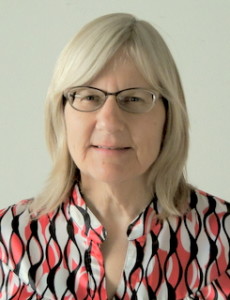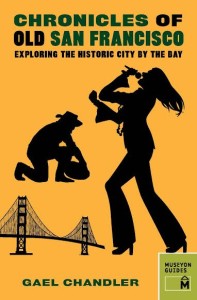Walking the Historic Streets of San Francisco
After 30 years in Los Angeles working as a film editor, teacher, and author of three books on editing, Gael Chandler returned to the Bay Area, where she wrote “Chronicles of Old San Francisco,” a history with walking tours, and embarked on a new career making video book trailers and enhanced eBooks. She also serves as vice-president and co-chair of programs for the Marin branch of California Writers Club.
Q: Tell me about your book.
The book is 28 tales of San Francisco history, with each chapter wrapped around a person, someone who personifies that history. There are also eight self-guided history walks, with directions on how to get to the start point without a car.
Q: How did you come to write it?
I was back east, and four hours after my mother died, I got an email from a friend, out of the blue, asking me if I’d be interested in writing a book called “Chronicles of Old San Francisco.” The book was to be part of a series published by Museyon—there was already “Chronicles of Old New York,” “Chronicles of Old Chicago,” etc. by different writers in different cities. My friend said ‘Because of your film books, I know you can write.’
So here I am grieving and planning a memorial service, and this incredible opportunity comes along.
I talked to my dad about the book. A lifelong Yankee fan, he said, ‘You’ve got to put in Joe DiMaggio.’ Ten weeks later, he unexpectedly died. I dedicated the book to both my parents. My mother died at the end of October, 2012, my dad in January 2013, and the book was due on Memorial Day. It was a big research job with a short deadline, but I got to pick who I wanted to write about. I talked to everyone I knew. The chapters were supposed to come in at 1500 to 1800 words. I turned in 2000 to 2200 word chapters.
Q: Did you have to write about famous people?
I had a great editor. She said, ‘We don’t want this to be just about dead white men.‘ ‘Good,’ I said. ‘That’s exactly how I think.’
But of course, many of the movers and shakers were white men. I “met” some incredible people, and have affection for all of them, even some of the scoundrels, like Henry Meiggs, a developer and the Bernie Madoff of his day. Meiggs’ intentions were good. He saw all this land in San Francisco, and thought, ‘we just need roads.’ But he ended up overextended, couldn’t pay for what he started. He wrote bad checks on the city, then set sail through the Golden Gate leaving everyone else holding the bag.
I became in thrall of Mary Ellen Pleasant. A hundred years before Rosa Parks, who was thrown off a streetcar in San Francisco because she was black, and then successfully sued over streetcar segregation. She was a friend and supporter of John Brown and the Underground Railroad. She cross-dressed to help free slaves, and amassed a fortune from opening laundries and other businesses. She owned a mansion on Octavia Street. But she was vilified, called Mammy Pleasant, brought down, and died penniless.
I started with the Ohlone Indians. Their names are lost to history, so I wrote about them as a group, in a chapter about Juan Bautista de Anza, one of the first Spanish explorers to encounter the Ohlone. Anza’s mission was to shepherd the first non-Indian settlers from Mexico to the Presidio.
Q: How did you find out about these people? Were they all dead? Did you have any opportunities to interview people?
Most of them were dead, as the publisher wanted closed stories. A few, like the founders of Wired, Jane Metcalf and Louis Rossetto, whose story is emblematic of the dot.com boom and bust, are alive. I didn’t have time or opportunity to do any primary interviews. I talked to everyone I knew, talked to personnel at the Presidio, took tours with City Guides—they do a terrific job. One of the guides gave me a bunch of names.
Q: So even though it was all secondary research, you were able to create something original? How did you make it not like a Wikipedia entry?
I’m a distiller. I like to take a mass of information and make it a pithy story. For each chapter I created an outline with the relevant information. But I didn’t have to start at the beginning. With Emperor Norton, I started with his death. With Andrew Hallidie, the problem of horse cars for public transportation. For Ina Coolbrith, with her receiving the California poet laureate award in 1919. Part of the joy was picking where to start.
Q: How did you choose the people?
I looked for influential people who embodied an age, who changed the city as the city changed them. People who were associated with San Francisco. Bill Graham was very much identified with San Francisco, and a way to hang the whole psychedelic era. I started with him whizzing around on his motor scooter at night putting up psychedelic posters. He pioneered the creation of groovy posters to promote concerts.
Of course, there were some people I had to include—John Sutter whose discovery of gold transformed the city forever; the “Big Four” railroad tycoons who built the Central Pacific Railroad—Leland Stanford, Collis Potter Huntington, Mark Hopkins, and Charles Crocker; Lawrence Ferlinghetti, the beat poet who opened City Lights Bookstore in North Beach.
Q: What did you learn from writing it?
A lot about the beginnings, middles, and endings of lives. A lot of the people I wrote about had humble beginnings, and ended up wealthy, some went the opposite way.
Lotta Crabtree got her start in Gold Rush country, dancing for miners. She became the “darling of San Francisco,“ the highest paid actress in the country. Lotta donated a fountain now named after her at Market, Geary, and Kearny, where people gather every year at 7am to commemorate the 1906 earthquake.
Many people I got in as sidebars. Like Joe Dimaggio, who was from here, but more identified as a New York Yankee. His parents weren’t allowed to fish in the bay because they were from Italy, which the U.S. had just fought in World War II. His father thought he was a no-goodnik because he wanted to play baseball instead of fishing.
Q: What was the hardest part?
Aside from the deadline—I had to write two chapters a week—was the self-doubt. There are a lot of historians out there. Who am I to write this? But someone gave me this opportunity and I was determined to take advantage of it. A lot of long-time locals have told me that they learned things from it, which has been very gratifying.
Q: How did you decide what history to tell? There must have been contradictory sources. Was there fact-checking?
In the contract I signed, the publisher indemnified itself against mistakes. With history, there’s always more than one version. I usually played it down the middle. Like with the “Big Four.” I ended the chapter with their houses burning down. They were hated. They monopolized the railroad industry. But they did some good things with their money. Stanford founded a college.
I tried to keep in mind people’s intentions. Like Mary Tape, a Chinese woman who fought for her children to be in an integrated public school and lost. I read a lot about her and other Chinese women of her era, the majority of whom came as indentured servants and were forced into prostitution. Mary might have been a prostitute, but it’s not clear. Luckily, she was helped by one of the famous missionary white women who saved her from the horrors of Chinatown.
Q: Tell me about the publishing and marketing part.
Since my book was part of a series, there was already a marketing mechanism in place. I created a website, a book trailer. My publisher, who’s from New York, came out here and personally took every step of the walking tour, and went to the DeYoung, Book Passage in the Ferry Building, and other places, persuading them to carry the book.
Of course, the publisher only does so much. I have to get out there and give talks. I’m doing one as part of Left Coast Writers at Book Passage October 10 at 7pm.
Q: What’s next?
You write a book and see where it takes you. I thought my next book would be fiction so I joined BAIPA, CWC (Marin and Redwood). At BAIPA I found out what a book trailer was. I decided to make one. I had never founded a company or had a business. I formed PictureYourBook with a partner this year to create book trailers. Now we’ve expanded to eBooks and we also create websites—the whole author package. I am in it for the creativity and to help authors. The variety of clients so far has been very interesting. And I am still contemplating that fiction book—something more personal.
To learn more, visit Gael Chandler’s websites: PictureYourBook, JoyofFilmmaking and TheSFStory.
***
John Byrne Barry is organizing an author-interviewing-author round-robin for BAIPA authors. Contact him at [email protected]

Thanks John for your time and astute question. I had a good time talking to you.